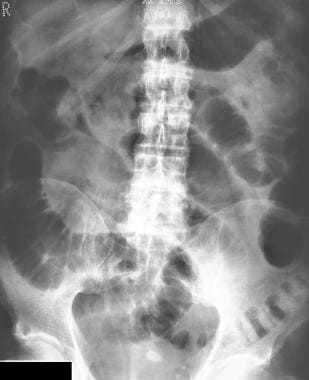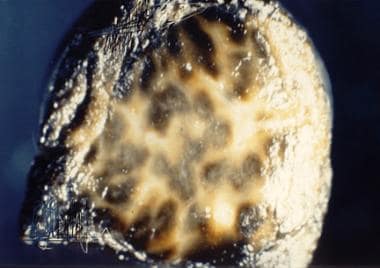Approach Considerations
Consider the diagnosis of Dubin-Johnson syndrome (DJS) in all individuals with elevated conjugated bilirubin levels with otherwise normal liver function test findings. The diagnosis can be confirmed by demonstrating an increase in the ratio of urinary coproporphyrin I to coproporphyrin III.
A combination of intense and prolonged visualization of the liver following intravenous administration of a radiopharmaceutical dye, with delayed to no visualization of the gallbladder, is unique to Dubin-Johnson syndrome.
Laboratory Studies
Laboratory studies in the evaluation of Dubin-Johnson syndrome (DJS) reveal conjugated hyperbilirubinemia, with total bilirubin serum levels usually in the 2- to 5-mg/dL range (but potentially as high as 25 mg/dL).
Results of other laboratory tests, including liver enzymes (aspartate aminotransferase [AST], alanine aminotransferase [ALT], and alkaline phosphatase [ALP]), serum albumin, and hematologic studies (eg, complete blood count [CBC], reticulocyte count), tend to be within reference ranges. Urine dipstick analysis may reveal bilirubinuria.
Prothrombin time is usually within the normal limits, but it can be prolonged in Iranian Jewish patients with associated factor VII deficiency. [29]
Reduced prothrombin activity resulting from lower levels of clotting factor VII is observed in 60% of patients with Dubin-Johnson syndrome.
Because MRP2 also transports leukotrienes into the bile, patients with Dubin-Johnson syndrome have defective biliary secretion and increased urinary excretion of leukotriene metabolites. This may become a noninvasive diagnostic assay for this condition. [40]
Coproporphyrins
Coproporphyrins are byproducts of heme biosynthesis. Normally, coproporphyrin I is preferentially excreted in bile, whereas coproporphyrin III is preferentially excreted in urine.
The urinary excretion of coproporphyrin isomers, however, has a fairly unique pattern in patients with Dubin-Johnson syndrome and can be used as a pathognomonic feature of the condition when congenital erythropoietic porphyria and arsenic poisoning have been excluded.
An increase in the urinary excretion of coproporphyrin I and a decrease in the excretion of coproporphyrin III are observed in Dubin-Johnson syndrome. [17] This results in total urinary coproporphyrin excretion (I+III) that is nearly normal when compared with unaffected individuals. The unique feature in Dubin-Johnson syndrome, however, is that 80% of the urinary coproporphyrin is type I in patients with Dubin-Johnson syndrome, compared with only 25% in other persons. [41] (Fecal coproporphyrin levels remain normal.)
In persons who are heterozygous for Dubin-Johnson syndrome, an intermediate ratio of urinary coproporphyrin I to coproporphyrin III is observed; these levels have been used to create family trees and to establish the recessive nature of the condition.
How a defect in an apical transporter creates this variance in urinary isomers remains unexplained, with several possible pathogenic mechanisms.
Interestingly, for the first 2 days of life, healthy neonates have ratios of urinary coproporphyrin similar to those seen in patients with Dubin-Johnson syndrome; by 10 days of life, however, these levels convert to the normal adult ratio. [42]
Imaging Studies
Computed tomography (CT) scanning findings in patients with Dubin-Johnson syndrome (DJS) reportedly show a significantly higher attenuation than that seen in control subjects. [43] Ultrasonography reveals a normal biliary tree and, in the first image below, demonstrates acalculous cholecystitis. The second image, a radiograph, shows acute cholecystitis.
 Dubin-Johnson Syndrome. A 26-year-old man known to be human immunodeficiency virus (HIV) positive presented with pain in the right upper quadrant and mild jaundice. This axial sonogram through the gallbladder (GB) and pancreas (P) shows sludge within the gallbladder and the lower common bile duct (CBD) (arrow). A diagnosis of acalculous cholecystitis was confirmed. A = aorta; IVC = inferior vena cava; S = splenic vein.
Dubin-Johnson Syndrome. A 26-year-old man known to be human immunodeficiency virus (HIV) positive presented with pain in the right upper quadrant and mild jaundice. This axial sonogram through the gallbladder (GB) and pancreas (P) shows sludge within the gallbladder and the lower common bile duct (CBD) (arrow). A diagnosis of acalculous cholecystitis was confirmed. A = aorta; IVC = inferior vena cava; S = splenic vein.
 Dubin-Johnson Syndrome. Plain abdominal radiograph from a patient with a clinical diagnosis of acute cholecystitis. The diagnosis was confirmed with abdominal ultrasonography. The radiograph shows faint opacities in the region of the gallbladder fossa and dilated loops of small bowel in the epigastrium and the midabdomen secondary to localized ileus.
Dubin-Johnson Syndrome. Plain abdominal radiograph from a patient with a clinical diagnosis of acute cholecystitis. The diagnosis was confirmed with abdominal ultrasonography. The radiograph shows faint opacities in the region of the gallbladder fossa and dilated loops of small bowel in the epigastrium and the midabdomen secondary to localized ileus.
Scintigraphy
Patients with Dubin-Johnson syndrome tend to have unique findings on hepatobiliary scans. Specifically, the liver is visualized immediately following intravenous administration of the radiopharmaceutical dye and remains intensely and homogeneously visualized for up to 120 minutes.
The gallbladder may be visualized after a delay of up to 90 minutes after dye injection in some patients and may not be observed at all in others. (Normally, images of the gallbladder are observed within 30 minutes after dye injection.)
This combination of intense and prolonged visualization of the liver and delayed or failed visualization of the gallbladder is unique to Dubin-Johnson syndrome in comparison with other primary liver abnormalities. These findings, however, can be mistaken for evidence of gallbladder disease if the patient presents with abdominal pain and may result in an unnecessary cholecystectomy.
Oral cholecystography fails to visualize the gallbladder in patients with Dubin-Johnson syndrome.
Procedures
In general, procedures are not necessary to confirm the diagnosis of Dubin-Johnson syndrome. If a patient is suspected of having the disease, the diagnosis can be confirmed by the test for urinary coproporphyrins, as described earlier.
Although a liver biopsy is not necessary for the diagnosis of Dubin-Johnson syndrome, patients may be noted to have a dark liver during routine surgery (eg, cholecystectomy), prompting biopsy.
Histologic Findings
Deposition of melaninlike pigment occurs in the livers of patients with Dubin-Johnson syndrome (DJS) but not in those with Rotor syndrome, a characteristic that helps to differentiate the two diseases. Macroscopically, the pigment can cause the liver to appear dark or almost black. (See the image below.)
 Dubin-Johnson Syndrome. Gross liver specimen from a patient with Dubin-Johnson syndrome showing multiple areas of dark pigmentation. Image courtesy of Cirilo Sotelo-Avila, MD.
Dubin-Johnson Syndrome. Gross liver specimen from a patient with Dubin-Johnson syndrome showing multiple areas of dark pigmentation. Image courtesy of Cirilo Sotelo-Avila, MD.
Microscopically, there is accumulation of coarsely granular pigment, which is most pronounced in the centrilobular zones (see the image below). No associated scarring, hepatocellular necrosis, or distortion of zonal architecture is present. The amount of pigment can vary among patients and within an individual. Certain diseases (eg, viral hepatitis) can cause the pigment to disappear. The pigment reaccumulates slowly once the acute process is resolved. Electron spin resonance spectroscopy suggests that the pigment is composed of polymers of epinephrine metabolites.
 Dubin-Johnson Syndrome. Microscopic histology of the liver in Dubin-Johnson syndrome showing multiple areas of granulated pigment. Fontana Mason stain. Image courtesy of Cirilo Sotelo-Avila, MD.
Dubin-Johnson Syndrome. Microscopic histology of the liver in Dubin-Johnson syndrome showing multiple areas of granulated pigment. Fontana Mason stain. Image courtesy of Cirilo Sotelo-Avila, MD.
The changes in the hepatocytes coexist with marked stimulation and enhanced phagocytic activity of Kupffer cells. [44] This manifests in the accumulation of pigment deposits within their cytoplasm that corresponds to those observed in hepatocytes. Hyperactive pericentral Kupffer cells, which are involved in the response to pigmentary material originating from disintegrated hepatocytes, may play an essential role in the development of Dubin-Johnson syndrome.
Other Tests
Genetic testing is crucial to establish an early diagnosis of Dubin-Johnson syndrome (DJS) in patients with atypical presentations, such as neonatal cholestasis. [15, 25] Genetic testing should also be performed to achieve an accurate diagnosis, thereby reducing unnecessary invasive examinations and avoiding misdiagnosis and mistreatment. [31]
Togawa et al found that targeted next-generation sequencing (NGS) can be used for molecular genetic diagnosis in patients with neonatal/infantile intrahepatic cholestasis (NIIC). [45] For 109 patients with NIIC who had no definitive molecular genetic diagnosis, the researchers developed a diagnostic custom panel of 18 genes and sequenced the amplicon library via NGS. A molecular genetic diagnosis was made for 28 subjects (26%), including 5 patients in the group with genetic cholestasis who were given the molecular genetic diagnosis of neonatal Dubin-Johnson syndrome. [45]
In a separate, retrospective study (2013-2016), Togawa et al indicated that immunohistochemical staining of the liver for multidrug resistance-associated protein 2 (MRP-2) as well as molecular genetic analysis of ABCC2 are essential elements for accurately identifying and diagnosing neonatal Dubin-Johnson syndrome. [21]
-
Dubin-Johnson Syndrome. Gross liver specimen from a patient with Dubin-Johnson syndrome showing multiple areas of dark pigmentation. Image courtesy of Cirilo Sotelo-Avila, MD.
-
Dubin-Johnson Syndrome. Microscopic histology of the liver in Dubin-Johnson syndrome showing multiple areas of granulated pigment. Fontana Mason stain. Image courtesy of Cirilo Sotelo-Avila, MD.
-
Dubin-Johnson Syndrome. Plain abdominal radiograph from a patient with a clinical diagnosis of acute cholecystitis. The diagnosis was confirmed with abdominal ultrasonography. The radiograph shows faint opacities in the region of the gallbladder fossa and dilated loops of small bowel in the epigastrium and the midabdomen secondary to localized ileus.
-
Dubin-Johnson Syndrome. A 26-year-old man known to be human immunodeficiency virus (HIV) positive presented with pain in the right upper quadrant and mild jaundice. This axial sonogram through the gallbladder (GB) and pancreas (P) shows sludge within the gallbladder and the lower common bile duct (CBD) (arrow). A diagnosis of acalculous cholecystitis was confirmed. A = aorta; IVC = inferior vena cava; S = splenic vein.





